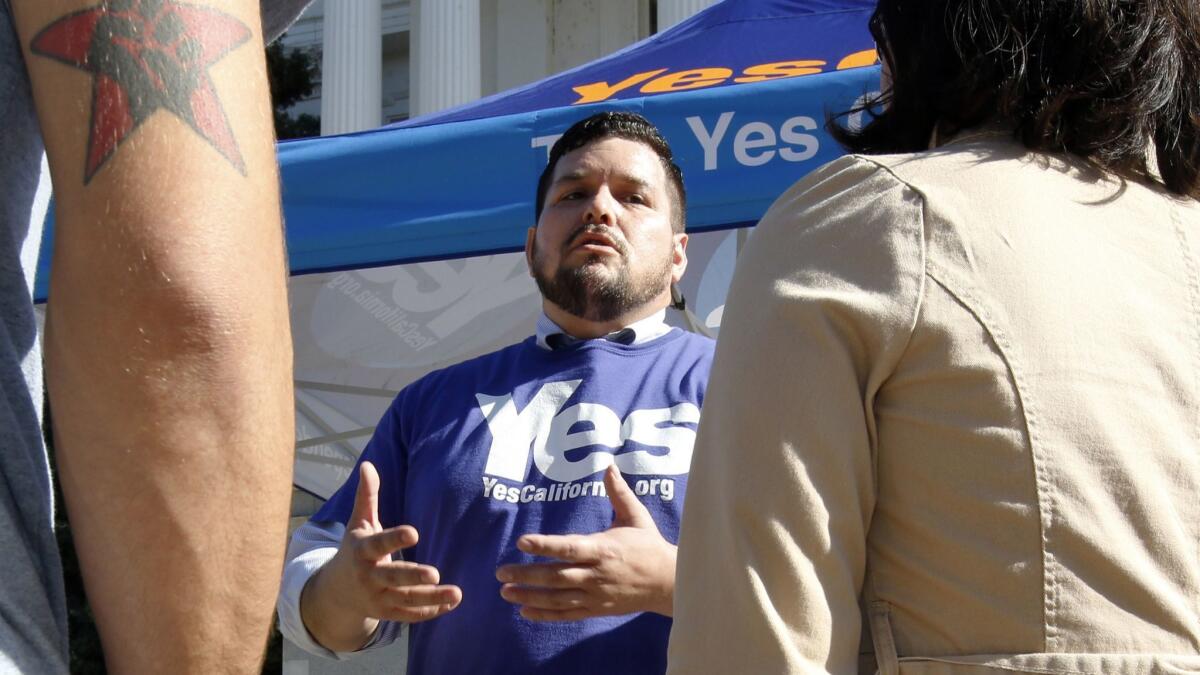‘Calexit’ leaders are back with a new plan to set aside land for Native Americans

- Share via
The activists behind the “Calexit” proposal to split off California are scrapping their old plans in favor of a new secessionist proposal, one that would create what organizers call an “autonomous native nation” within a new independent state.
The California secretary of state cleared the group Yes California in April to begin collecting signatures from voters to place on the 2021 ballot the question of whether California should secede from the United States.
But with the group’s Oct. 17 deadline to deliver signatures from 365,880 registered voters fast approaching, organizers are moving away from that effort and redirecting resources to the new proposal, said Marcus Ruiz Evans, president of Yes California.
Updates on California politics »
The new plan would combine secession with the creation of the autonomous native nation within that newly independent state of California, Evans said.
He said previous Calexit proposals have been criticized for not doing enough for Native Americans. The new proposal seeks to address that by handing off a large swath of a theoretical new California, he said. An illustration provided by Yes California shows the state bisected from Oregon to the U.S.-Mexico border, with the new California comprising western, coastal areas and the autonomous native nation containing inland regions.
According to the U.S. census, California is home to the largest Native American population in the country, and there are more than 100 federally recognized tribes in the state. Evans said the group has not “officially” communicated with representatives from tribal nations in California, but it plans to start soon.
Calls and emails to the Inter-Tribal Council of California and the Governor’s Office of the Tribal Advisor were not immediately returned Tuesday.
“What we want to do is have this start a dialogue with Native people. Then we are going to be quiet and listen,” he said. “This is just part one. A whole lot has to be done. We need to do our homework.”
Evans said the current boundaries for the autonomous native nation are based roughly on the location of federal land in the eastern half of the state. However, federally recognized tribes also live in the new California.
Evans said the group has to finalize its plans before beginning the process of gathering signatures to qualify the new proposal for the ballot.
The proposed new nation’s relationship with an independent California would be similar to relations between Greenland and Denmark, he said. The island country was granted self-government by the Danish parliament in 1979 and has since moved toward increased self-governance.
There have been more than 200 efforts to cut up California since 1849 — and all have failed.
Evans said the Calexit signature gathering effort with the looming October deadline is going slow. The secretary of state’s office has not received the legally required notice from organizers that they have gathered 25% of the signatures needed for the proposed measure.
The California Supreme Court decided unanimously last month to remove from the November ballot a separate measure aimed at dividing California into three states that was backed by Silicon Valley billionaire Tim Draper.
The idea of secession isn’t terribly popular with voters, according to two polls released in January 2017. About 32% of voters contacted in a Reuters/Ipsos opinion poll supported peaceful withdrawal from the union. A Stanford University poll in 2017 found that only about 27% of the survey’s respondents backed California secession.
Evans said the public may be getting tired or confused by repeated efforts to secede or split up California. His group has tried and failed in recent years to put the question before voters.
But he said the effort could become more popular among the state’s liberal majority — especially if Democrats fail to win control of the House of Representatives in the fall or if President Trump is reelected in 2020.
“I’ve seen Americans double down on stupid in my lifetime, and they are fully capable of doing it again,” he said. “We think Calexit is going to be bigger than ever.”
Twitter: jpanzar
More to Read
Get the L.A. Times Politics newsletter
Deeply reported insights into legislation, politics and policy from Sacramento, Washington and beyond. In your inbox twice per week.
You may occasionally receive promotional content from the Los Angeles Times.











